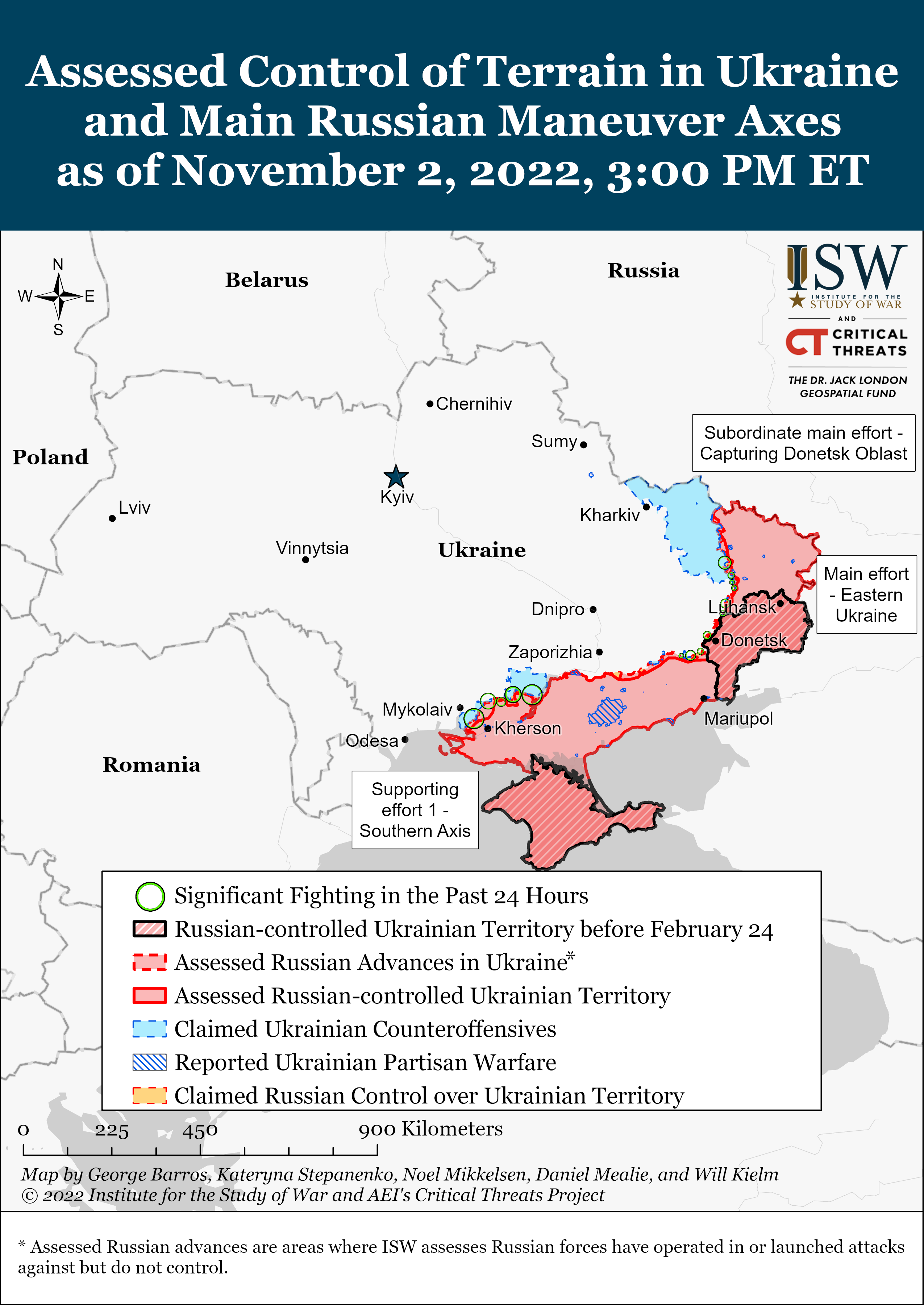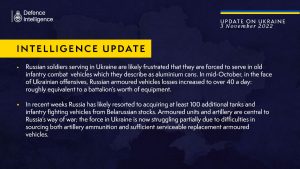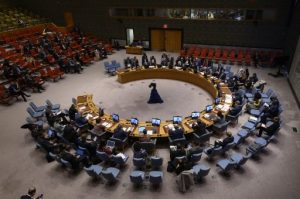
ISW Russian Offensive Campaign Assessment, November 2 – Kyiv Post
Key Takeaways
- Russian force generation efforts combined with Western sanctions are having long-term damaging effects on the Russian economy, as ISW has previously forecasted.
- Russian President Vladimir Putin’s calls for a competitive Russian military industry are divorced from the reality of Russian supply chain and defense industrial base issues.
- Russian officials announced that occupation authorities began integrating the Zaporizhzhia Nuclear Power Plant (ZNPP) into Russian jurisdiction.
- Russian and Belarusian officials continue to perpetuate the long-standing information operation that Belarus will enter the war in Ukraine on behalf of Russia, but Belarus’ entry into the war remains highly unlikely, as ISW has previously assessed.
- Russian sources claimed that Ukrainian forces continued to conduct counteroffensive operations in the directions of Svatove and Kreminna, and Russian forces conducted offensive operations to constrain Ukrainian forces.
- Russian forces continued defensive operations along the Dnipro River while Ukrainian forces continued their interdiction campaign.
- Russian forces continued to conduct ground assaults near Bakhmut and Donetsk City.
- Russian forces continued mobilization efforts and advertising for volunteer battalions while struggling with low morale.
- Russian occupation authorities continued to forcibly relocate Kherson Oblast residents, nationalize Ukrainian enterprises in occupied territory, and forcibly deport Ukrainian children to Russia.
Russian force generation efforts combined with Western sanctions are having long-term damaging effects on the Russian economy, as ISW has previously forecasted. Financial experts told Reuters that the Kremlin will face a budget deficit that will “drain Moscow’s reserves to their lowest level in years” due to projected decreases in energy revenue, sanctions, and the cost of Russian mobilization. One expert predicted that payouts to mobilized men including social benefits may cost the Kremlin between 900 billion rubles and three trillion rubles (around $14.6-$32.4 billion) in the next six months. The number does not account for payouts to other categories of servicemen within the Russian forces such as BARS (Combat Army Reserve), volunteer battalions, and the long-term commitment to veterans’ payments to contract servicemen, volunteers, non-military specialists who moved to occupied territories, and proxy fighters. ISW previously estimated that one volunteer battalion of 400 servicemen costs Russia at least $1.2 million per month excluding enlistment bonuses and special payments for military achievements.
The Kremlin is continuing to rely heavily on financially incentivizing Russians to fight in Ukraine, which will likely continue to strain the Russian economy for decades. Russian officials have been promising salaries to volunteers and mobilized men that are more than twice the average Russian civilian salary before and during Russia’s full-scale invasion of Ukraine. The Kremlin has been attempting to deflect part of the cost of the force generation effort onto Russian federal subjects but will likely need to tap into the federal budget more heavily soon. United Russia Party Secretary Andrey Turchak, for example, stated that Russian servicemen from all regions must receive uniform benefits and noted that the federal government must cover the difference if the federal subject is unable to fully compensate all participants of the “special military operation.” Donetsk People’s Republic (DNR) Head Denis Pushilin even acknowledged that there are insufficient measures in place to support mobilized personnel and their families in occupied Donetsk Oblast during a United Russia meeting.
The Kremlin is already facing challenges in delivering promised compensation, challenges that are increasing social tensions within Russian society. Russian Telegram channels released footage of mobilized men in Ulyanovsk protesting payment issues. Other footage from the Chuvashia Republic shows a presumably Russian local official yelling at protesting mobilized men that she had not promised them a payment of 300,000 rubles (about $4,860). Families of mobilized men publicly complained to Voronezh Oblast Governor Alexander Guseyev that they have not received promised compensation of 120,000 rubles (about $1,945). The Kremlin will need to continue to pay what it has promised to maintain societal control and some resemblance of morale among Russia’s ad hoc collection of forces. ISW has also reported that the Kremlin is igniting conflict within Russian military formations amalgamated from different sources by offering different payments, benefits, and treatment. Social media footage from October 31, for example, showed a physical fight between contract servicemen and mobilized men reportedly over personal belongings and military equipment.
Russian President Vladimir Putin’s calls for a competitive Russian military industry are divorced from the reality of Russian supply chain and defense industrial base issues. Putin stressed on November 2 during a meeting of the Coordinating Council for the Russian Armed Forces that it is important that the Russian government ensures active competition between Russian military arms manufacturers. Putin’s calls contrast with recent reporting that Russia has purchased weapons systems from Iran and North Korea to support its war effort in Ukraine. US National Security Council spokesman John Kirby announced on November 2 that the American intelligence community believes that North Korea is covertly supplying Russia with artillery shells. ISW previously reported that Iranian shipments of drones and possible ballistic missiles to Russia will likely further increase Russian reliance on Iranian-made weapons systems. Russia has likely negotiated the weapon shipments with Iran and North Korea because it has significantly depleted its stock of munitions in air, missile, and artillery strikes over the course of the war in Ukraine and cannot readily restock them. Russia’s reliance on isolated and heavily sanctioned states for critical weapons systems does not support Putin’s demand that the Russian military industry becomes highly competitive and meets the needs of the Russian Armed Forces in any short period of time.
Russian officials announced that occupation authorities began integrating the Zaporizhzhia Nuclear Power Plant (ZNPP) into the jurisdiction of Russian nuclear power plant operator Rosenergoatom on November 2. Russian Deputy Foreign Minister Andrey Rudenko claimed that ZNPP personnel who are “critical for the work of the ZNPP” signed contracts with Rosenergoatom and that Russian authorities are exploring the creation of a security zone around the ZNPP. Ukraine’s Energoatom stated on October 28 that only 100 of the 6,700 Ukrainian personnel remaining at the ZNPP plant have signed new contracts with the Russian energy agency Rosatom (out of 11,000 personnel before February 24). The Ukrainian State Inspectorate of Nuclear Regulation stated that Russian forces built an unknown structure at one of seven spent nuclear fuel storage sites at the ZNPP in violation of nuclear safety standards. As of this publication, the International Atomic Energy Agency (IAEA) has not issued a statement condemning the formally announced illegal Russian takeover of the operation of the ZNPP or addressed the likelihood that Russia will demand formal IAEA recognition of Russian control over the ZNPP and thereby de facto recognition of the Russian annexation of occupied Ukrainian territory.
Russian and Belarusian officials continue to highlight bilateral defense cooperation between Russia and Belarus as a means of perpetuating the long-standing information operation that Belarus will enter the war in Ukraine on behalf of Russia. Belarus’ entry into the war remains highly unlikely, as ISW has previously assessed. Belarusian Defense Minister Viktor Khrenin announced on November 2 that Russia and Belarus held the annual meeting of the Joint Board of the Ministries of Defense with the purpose of strengthening the “joint military potential” of the Russia-Belarus Union State to counter “challenges and threats of a military nature” posed by NATO. Khrenin’s statement is likely meant to signal continued Belarusian loyalty to Russia and present an image of Belarusian-Russian military unity to the West. As ISW has previously assessed, Belarus’ entry into the war remains highly unlikely due to the array of domestic ramifications such an action would have on President Alexander Lukashenko’s regime, as well as limited Belarusian military capabilities. The meeting of the Joint Board of the Ministries of Defense is therefore a continuation of a concerted effort on the part of both Belarus and Russia to perpetuate an information operation that presents the threat of the Union State as imminent in order to pin Ukrainian troops against the northern border and pollute the information space.


Average Rating